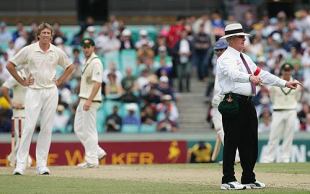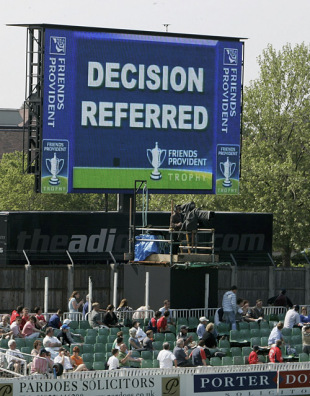
|

If an umpire makes an incorrect call, the referrals system allows him to be challenged, and in effect, it is challenging him to not be wrong so often © Getty Images
|
|
Not just in cricket, human unease over technology - a vague, ambivalent, catch-all term, really - permeates modern life. It isn't the existence of technology, or indeed its use, for nobody is fussed about flying to a country within hours, a journey that otherwise took months, or sending email where once it took weeks to get a message across. No, this is all good.
What we are paranoid about is technology's final destination, where its advance will end. It started as our slave, but will it end as our master? Some of our jobs are already gone. Eventually it will make us all redundant. At worst, technology will take us over, as Hollywood directors and crackpot novelists warn us. At best, it will smother our unique genius, make us lazy, and chip away steadily at our soul and the planet we occupy.
And this is really the heart of an exceedingly shrill debate, in life, in cricket. It is not that we have not benefited from technology or that it is often needed to assist us, or umpires - for that admission has long been made. It is: how much more technology? A few bad decisions in high-profile matches and immediately lines are drawn: we need much more, shout some. We're fine just the way we are, scream back others. In the middle, looking at either side, it is barren.
Such has been the fallout from Sydney, where awful umpiring has once again got machine-made, mass-produced knickers in a twist. The ICC has pleased technophiles and enraged traditionalists by proposing trial use of a referral system - an idea first mooted in 2002 by Duncan Fletcher - at the 2008 Champions Trophy in Pakistan.
The system allows each side to appeal instantly against what they feel are incorrect umpiring calls, referring the decision to the third umpire, who, calling upon the wonder of technology that is the television, will adjudicate on the appeal. Each side will be allowed three appeals per innings, none deducted if appeals are upheld. Tennis has beaten us to it and England, cricket's home, has already tasted it, more of which later.
Arguments for or against referrals - and thus more or less technology - are equally compelling, and opinion increasingly polarised. On the one hand, it is difficult to not be seduced by the case for referrals and more technology, if only because it is difficult to argue against wanting to be right more, which is the aim. Cricket, sport, is one of life's few realms where you can still be black or white, right or wrong, about decisions; not always but often. Footballs either do or don't cross the line, balls are edged or they aren't.
Replays aren't always conclusive, but where is the harm in using something that might help? Will a referral be too time-consuming? Not really, for replays are already in use, and in a game which at its shortest lasts over three hours and in original form, 35, a minute or two hurts no one. Less so if spent in the pursuit of getting things right. And even if replays are inconclusive, the benefit of doubt will be given to batsmen, the decision to the on-field umpire. Cricket's oldest codes remain untouched.
But where does this stop, ask detractors, the query implying that it does so when umpires - like humans - become redundant, white coat-hangers. This forgets that gadgetry or not, there remains an on-field decorum to maintain, a whole field of 13 highly competitive, adrenalised men or women to police over, or more importantly, to maintain a veneer of policing over. Disputes between players, decisions from square leg, ball tampering, not to mention presiding over any number of decisions that technological aids still cannot conclusively decipher; on-field umpires are and will remain essential. And, of course, someone, preferably human, needs to control and interpret what technology churns out.
But even if the influence of the on-field umpire is diminished, is it such a bad thing? Why are we so precious about umpires? They are humans, prone to moods and attitudes, they get annoyed, they wilt under pressure, they screw up, make judgment errors and like everybody else in sport and life, should be accountable for them. Did not Darrell Hair's attitude hammer home this very point in 2006? And if Steve Bucknor grumpily traipses the world, gracing contests all over with his incompetence, should he not pay a price for it?
If the ICC does trial the referrals system, who will oversee it? Who will provide the technology, the finances? And whose behind will be on the line if it goes belly up? TV channels?
Just appoint better umpires? Sure, but isn't one way of doing that making them more accountable? If an umpire makes an incorrect call, the referrals system allows him to be challenged, and in effect, it is challenging him to not be wrong so often. Some umpires, it can be argued, quite need to have their authority questioned; if their decisions are continually referred and overruled, it will force the poorer ones to shape up or ship out, and neither is bad for cricket.
Ultimately, say technophiles, what difference will greater use of technology actually make? Who could be unhappy with more correct decisions? How does it take away from the game? It doesn't stop fine batting, great bowling, outstanding fielding, astute leadership or an absorbing contest.
And here we flip.
Is there really a need to tinker with the game? Awful umpires have come and gone, horrendous decisions have come, turned contests, and gone, but cricket is still here. And it is in a good place right now. It has overcome match-fixing, makes good money, despite one team's dominance and that of bat over ball. Test cricket is alive again, and last year the staleness of 50 overs was offset by the freshness of 20.
Poor decisions are but a small part of this, never completely forgotten but only rarely the source of long-term, broader damage (not with neutral umpires in any case). They add to the fable. They even, many say, enhance the game's charm: batsmen make mistakes, bowlers do and so umpires are allowed to also. It gives the game its humanity.
They don't even out with enough precision to please a mathematician perhaps, but do in a serendipitous way. India were denied a draw in Sydney by Bucknor, but were saved from certain defeat at Lord's last summer by rain and ... Bucknor. Cricket lives with such karmic balancing.
Some of the more tangible concerns against increased use of technology are practical and thus forceful. Steve Crawley, an executive sports producer with Channel 9, recently said that of the three most widely used TV aids, Snicko, Hawk-Eye and Hot Spot, only the last was foolproof. "We've only got one thing 100% backed up by science and that's Hot Spot. The others aren't 100%." Snicko can be doctored to synchronise the visual of ball passing bat with a sound registering on the adjacent graph, even if the two didn't occur simultaneously. The predictive qualities of Hawk-Eye, meanwhile, remain just that: predictive not definitive. Should we really use them if there is such doubt? Moreover, if the ICC does trial the system, who will oversee it? Who will provide the technology, the finances? And whose behind will be on the line if it goes belly up? TV channels?
Possibly the greatest concerns, however, to hang over the system - and the use of more technology - come from the English county season just gone, when referrals were trialled during the Friends Provident trophy and scrapped immediately after.
Numerous problems emerged, micro and macro, some resolvable, others not immediately so. Hawk-Eye and Snicko, for starters, were not used, which not only confirms Crawley's worries, but also renders the video referral almost ineffective. The first decision referred was for lbw. Unsurprisingly, the umpire, Barrie Leadbetter, upheld the decision from replays. "I was looking for an obvious error and there was none." TV umpires would only act to overturn if a glaring error was made, but should they have been more empowered, more proactive?
There was also confusion over what constituted an "immediate" referral: could a batsman wait till a replay had been seen? Should replays be delayed? But the real problem seems to have been an earthy one, a difficulty in changing embedded human perception about technology and its limitations.

|

An all too short experiment: the first referred decision at last summer's Friends Provident Trophy
© Getty Images
|
|
The exact number of referrals made is unknown, but the telling statistic is that not a single decision was overturned. By season's end, it was said that TV umpires were unwilling to overturn their on-field colleagues' decisions. So they came together, a union against technology, admirable to some, pig-headed to others. Before the final, both captains agreed to not use the system, as had quietly been happening in a number of games in any case. Chris Adams, the first to contest a decision - a leg-before - said he felt awkward doing it.
Unwittingly, here lay the heart of the matter. This was a failure, yes, but as much of imperfect technology, as of human will to give that technology a fair go. Not recognising this, as is apparent in the scrapping of the county experiment, is to miss the middle ground.
Certain decisions in cricket, mostly dubious catches, leg-before calls and thin edges, are unlikely to become clearer through replays or gizmos, for which the umpire's eye remains supreme. But a greater number and variety of decisions than before - not just line calls - can now be made correctly because of technology. Some, like Andrew Symonds' edge off Ishant Sharma, and Rahul Dravid's invisible one off Symonds, are so clearly wrong that they ought to be referred. In fact, instances like these - and unnoticed no-balls - perhaps represent an opportunity for the third umpire to play a more proactive role, of pointing out an obvious, glaring error.
Implementing a referrals system will not kill the game. It might eventually make umpires better. But using it will also highlight the problems inherent with technology, some of which surfaced in England, and which must be resolved before there can be real progress. If the ICC is serious about the referrals system, then it must also be serious about giving it a fair run.
"Technology... ," the English writer and physicist CP Snow said, "is a queer thing. It brings you great gifts with one hand, and it stabs you in the back with the other." To grasp this, to acknowledge and accept it, is to stand in the middle ground. It is a ground cricket must occupy if it is to truly come to terms with technology.

